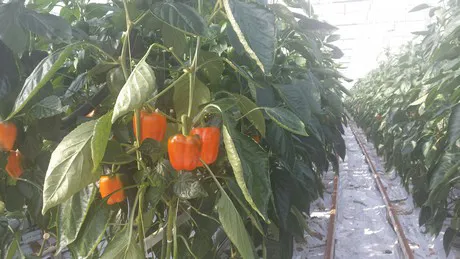Dutch-grown orange bell peppers have been on the market since mid-March again. "The supply started nice and gradually," says grower, Ted Zwinkels of the farm, Zwingrow, in the Netherlands. He is a member of the Oranje Paprikavereniging (Orange Bell Pepper Association). “The supply is spread out a lot among the members. This fits in well with the gradual build-up to the season. It also fits with the switch retailers are currently making."

A peek into Zwingrow's greenhouse.
This spread is a result of, among other things, problems with this product's seeds and growth. "The seeds do not meet the requirements in all cases," Ted has learned from his fellow farmers. "This has resulted, in some cases, that the seeds had to be resown. The growers were forced to postpone their planting dates. By chance, this did not happen here."
"For growers, this is, of course, very frustrating. However, this could end up being beneficial. There are different production rhythms. These differences mean production peaks at the start of the season have been avoided. And you, as a grower, might be able to benefit from better prices. That is if the supply of orange bell peppers is more spread out in the coming year."
More demand from the US
The demand for orange bell peppers has been good right from the beginning of the season. "You will notice that supermarket no longer carry flow packs. This is due to quality problems in Spain. In recent years, orange bell peppers increasing replaced the green ones in these 'traffic light' flow packs. There are also more orange bell peppers being sold in the supermarkets, loose too. The extra marketing we did is bearing fruit, for sure."
Marketing is mostly aimed at the Netherlands, Germany, and England. The United States is also an important sales market. "It can vary, depending on the period. But, in the first weeks of the season, you immediately saw more demand, from the US too."
Orange follows red and yellow in productivity and growth power
In the past few years, the acreage used to grow orange bell peppers increased gradually. Currently, it is about 100 hectares in the Netherlands. “On average, a few hectares are added every year. This is also the case this year," explains Ted. Acreage is also expanding in other countries. However, the Netherlands is still the orange bell pepper country par excellence.
"If you look at the color chart, the percentage of orange bell peppers grown in the Netherlands is much larger than in other countries. The Netherlands is a real frontrunner. The cultivation of this product was developed here. Other countries are now following suit," he continues.
Ted does see a development. The orange bell pepper varieties are becoming increasingly robust and productive. "Yet, orange bell pepper production is still at a lower level than that of the red and yellow kinds. Big steps are taken in the production of red and yellow bell peppers. The orange sector then often also follows some time later," concludes the grower.
For more information:
Oranje Paprikavereniging
www.oranjepaprika.eu
Ted Zwinkels
info@oranjepaprika.eu
